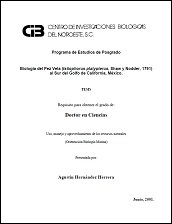The effect of climate variability on gray whales (Eschrichtius robustus) within their wintering areas
Autor
CHRISTIAN JAVIER SALVADEO
ENRIQUE ALEJANDRO GOMEZ GALLARDO UNZUETA
JORGE DE JESUS URBAN RAMIREZ
DANIEL LLUCH BELDA
Metadatos
Mostrar el registro completo del ítemResumen
"The environmental conditions of the breeding and feeding grounds of the gray whale (Eschrichtius robustus) fluctuates at inter-annual scales in response to regional and basin climate patterns. Thus, the goals of this study were to assess if there are any relationships between summer sea ice on their feeding ground and counts of gray whale mother-calf (MC) pairs at Ojo de Liebre Lagoon (OLL); and if El Niño Southern Oscillation (ENSO) influences the winter distribution of gray whales MC pairs in the three primary breeding lagoons of OLL, San Ignacio Lagoon (SIL) and Santo Domingo Channel north of Bahia Magdalena (SDCh). Maximum February counts of MC pairs were compared with the length of the open-water season at the Bering Sea during the previous year. Then, an ENSO index and sea surface temperature anomalies outside the primary lagoons was compared with the maximum February counts of MC pairs at these lagoons. Results showed that maximum counts of MC pairs in OLL correlates with sea ice conditions in their feeding grounds from the previous feeding season, and this relationship can be attributed to changes in nutritive condition of females. ENSO-related variability influences distribution of MC pairs in the southern area of SDCh during the warm 1998 El Niño and cold 1999 La Niña. This supports the hypothesis that changes in the whales’ distribution related to sea temperature occurs to reduce thermal-stress and optimize energy utilization for newborn whales. Although this last conclusion should be considered in view of the limited data available from all the whales’ wintering locations in all the years considered."
Colecciones
Ítems relacionados
Mostrando ítems relacionados por Título, autor o materia.
-
PROMOCIÓN DEL PERIFITON PARA EL CULTIVO DE CAMARÓN BLANCO: HACIA UNA ACUICULTURA ECOLÓGICA
DOMENICO VOLTOLINA LOBINA; JUAN MANUEL AUDELO NARANJO; MARIA DEL ROSARIO PACHECO MARGES -
Suelo y Erosión
YOLANDA LOURDES MAYA DELGADO


